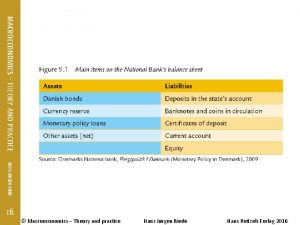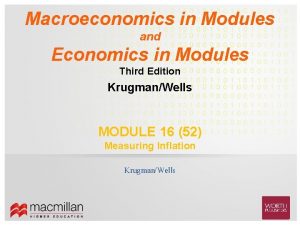Macroeconomics in Modules and Economics in Modules Third














- Slides: 14

Macroeconomics in Modules and Economics in Modules Third Edition Krugman/Wells MODULE 28 (64) Aggregate Supply

What You Will Learn 1 How the aggregate supply curve illustrates the relationship between the aggregate price level and the quantity of aggregate output supplied in the economy 2 What factors can shift the aggregate supply curve Why the aggregate supply curve in the short run 3 is different from the aggregate supply curve in the long run 2

The Aggregate Supply Curve • The aggregate supply curve shows the relationship between the aggregate price level and the quantity of aggregate output in the economy. 3

The Short-Run Aggregate Supply Curve • The short-run aggregate supply curve is upward-sloping because nominal wages are sticky in the short run: – a higher aggregate price level leads to higher profits and increased aggregate output in the short run. • The nominal wage is the dollar amount of the wage paid. • Sticky wages are nominal wages that are slow to fall even in the face of high unemployment and slow to rise even in the face of labor shortages. 4

The Short-Run Aggregate Supply Curve Aggregate price level (GDP deflator, 2005 = 100) Short-run aggregate supply curve, SRAS 10. 6 7. 9 0 1929 A movement down the SRAS curve leads to deflation and lower aggregate output. 1933 $716 977 Real GDP (billions of 2005 dollars) 5

Shifts of the Short-Run Aggregate Supply Curve (b) Rightward Shift (a) Leftward Shift Aggregate price level SRAS 2 SRAS 1 Decrease in short-run aggregate supply Real GDP SRAS 1 SRAS 2 Increase in short-run aggregate supply Real GDP 6

Shifts of the Short-Run Aggregate Supply Curve • Changes in commodity prices, nominal wages, or productivity lead to changes in producers’ profits and shift the short-run aggregate supply curve. 7

Factors that Shift Short-Run Aggregate Supply Changes in commodity prices If commodity prices fall If commodity prices rise Short-run aggregate supply increases Short-run aggregate supply decreases Changes in nominal wages If nominal wages fall If nominal wages rise Short-run aggregate supply increases Short-run aggregate supply decreases Changes in productivity If workers become more productive If workers become less productive Short-run aggregate supply increases Short-run aggregate supply decreases 8

Long-Run Aggregate Supply Curve • The long-run aggregate supply curve shows the relationship between the aggregate price level and the quantity of aggregate output supplied that would exist if all prices, including nominal wages, were fully flexible. 9

Long-Run Aggregate Supply Curve Long-run aggregate supply curve, LRAS Aggregate price level (GDP deflator, 2005 = 100) 15. 0 …leaves the quantity of aggregate output supplied unchanged in the long run. A fall in the aggregate price level 7. 5 0 Potential output, YP $800 Real GDP (billions of 2005 dollars) 10

Actual and Potential Output from 1989 to 2009 11

From the Short Run to the Long Run (a) Leftward Shift of the Short-Run Aggregate Supply Curve Aggregate price level (b) Rightward Shift of the Short-Run Aggregate Supply Curve Aggregate price level LRAS SRAS 2 P 1 A fall in nominal wages shifts SRAS rightward. A 1 A rise in nominal wages shifts SRAS leftward. YP Y 1 SRAS 2 SRAS 1 A 1 P 1 SRAS 1 Real GDP Y 1 YP Real GDP 12

Economics in Action Prices and Output During the Great Depression 13

Summary 1. The aggregate supply curve shows the relationship between the aggregate price level and the quantity of aggregate output supplied. 2. The short-run aggregate supply curve is upward sloping because nominal wages are sticky in the short run. 3. Changes in commodity prices, nominal wages, and productivity lead to changes in producers’ profits and shift the short-run aggregate supply curve. 4. In the long run, all prices are flexible and the economy produces at its potential output, and the long-run aggregate supply curve is vertical at potential output. 14
 Macroeconomics in modules
Macroeconomics in modules Branch of economics
Branch of economics Economics modules
Economics modules Gingival third vs cervical third
Gingival third vs cervical third Gj mount classification
Gj mount classification Maastricht university economics and business economics
Maastricht university economics and business economics Principles of economics third edition politeknik
Principles of economics third edition politeknik Mathematical economics vs non mathematical economics
Mathematical economics vs non mathematical economics Macro vs micro definition
Macro vs micro definition What is macroeconomics
What is macroeconomics New classical macroeconomics
New classical macroeconomics Nicepp
Nicepp Macroeconomics theory and practice
Macroeconomics theory and practice New classical and new keynesian macroeconomics
New classical and new keynesian macroeconomics Economics subject
Economics subject


























